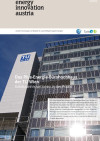Suchergebnisse für "Factsheet%3A Energietechnologien gestalten%2C die f%C3%BCr alle sinnvoll und nutzbar sind"
IEA Wind TCP: Annual Report 2020
Der Jahresbericht liefert Informationen zum Fortschritt der Partnerländer beim nationalen Ausbau der Windenergie sowie zu aktuellen Aktivitäten und Erfolgen in den 17 internationalen Forschungskooperationen.
Smart Cities Demo 2020 – Boosting Urban Innovation
Thematischer Schwerpunkt der heurigen Ausschreibung ist urbane Resilienz v.a. im Lichte des Klimawandels. "Smart Cities Demo" ist ein Programm des Klima- und Energiefonds der österreichischen Bundesregierung. Einreichschluss ist der 20. Oktober 2020.
IEA Bioenergy News Bulletin März 2021

Das Nachrichtenblatt gibt einen kurzen Überblick über aktuelle Neuigkeiten aus den Tasks sowie kommende Veranstaltungen.
Herausgeber: IEA Bioenergy TCP, 2021
Englisch
IEA AFC Annex 33: Bericht “Possible extension of the business model for fuel cells – justification for potential subsidies for the installation of fuel cells from the cost accounting perspective" (2019)

Der Bericht zeigt mögliche Erweiterungen von Geschäftsmodellen in Bezug auf Brennstoffzellen.
Schuch, Alfred, Simader, Günter
Herausgeber: IEA AFC TCP Annex 33
Englisch, 50 Seiten
Downloads zur Publikation
IEA SHC Task 68: Konferenz EuroSun 2022 Beitrag "Fault Detective - Automatic Fault Detection for Solar Thermal Systems based on Artificial Intelligence" (2022)

Präsentation im Rahmen der Konferenz EuroSun 2022 in Kassel, Deutschland.
Lukas Feierl, Thomas Bolognesi, Viktor Unterberger, Manuel Gaetani, Bernhard Gerardts, Claudio Rossi
Herausgeber: SOLID Solar Energy Systems GmbH
Englisch, 2 Seiten
Info-Veranstaltung: ChristophorusHaus - Tag der offenen Tür
18. - 19. Okt 2008
4651 Stadl-Paura, AT
Das ChristophorusHaus Stadl-Paura lädt anlässlich seines fünfjährigen Bestehens zu Tagen der offenen Tür. Das ChristophorusHaus öffnet seine Türen am Samstag, 18.10. und Sonntag, 19.10. von jeweils 11 Uhr bis 16 Uhr.
LifeCycle Tower auf dem ERSCP2012
Auf dem European Round Table for Sustainable Consumption and Production 2012 stellte Michael Zangerl von Cree das Baukonzept des LifeCycle Towers in Rahmen der "Battle of Towers" vor. Eine Exkursion führte zum "Haus der Zukunft Plus"-Demonstrationsgebäude, das in Modulbauweise errichtet wird.
P2PQ - Peer2Peer im Quartier

Das Projekt Peer2Peer im Quartier befasst sich mit der konkreten Umsetzung von Anwendungen zu Photovoltaik-Eigenverbrauchsoptimierung sowie Peer-to-Peer-Beziehungen auf Basis der Blockchain-Technologie in Quartieren und deren Validierung im Echtbetrieb.
Schriftenreihe
26/2022
Herausgeber: BMK
Deutsch, 43 Seiten
Downloads zur Publikation
Ausstellung: Baufamilien-Tag
30. Mai 2010
1. Europäisches Passivhausdorf zum Probewohnen3922 Großschönau, AT
Der Sonnenplatz Großschönau veranstaltet am 30. Mai 2010 einen Baufamilien Tag. Dieses Mal zum Schwerpunktthema "Photovoltaik/Solaranlage".
IEA DHC: Projektbericht - Leave second generation behind: Cost-effective solutions for small to large scale DH networks

Abschlussbericht des Projektes “Leave second generation behind”, mit einem Fokus auf der Entwicklung von kosteneffizienten Lösungen zur Senkung der Vorlauftemperatur für unterschiedliche Netzgrößen.
Guelpa E, Capone M, Vasset N, Sciacovelli, P. Niknam, Merlet Y, Baviere R, and Verda V.
Herausgeber: IEA DHC, 2023
Englisch
Ausstellung: Baufamilien-Tag
25. Jan 2009
Sonnenplatz Großschönau
Großschönau, AT
Der Sonnenplatz Großschönau veranstaltet am 25. Jänner 2009 einen Baufamilien Tag. Dieses Mal zum Schwerpunktthema Wärmepumpe.
10. Österreichische Photovoltaik Tagung
18. - 19. Oktober 2012
Conference Center Laxenburg, Schlossplatz 1
2361 Laxenburg, AT
Photovoltaik - Innovationen für den internationalen Wettbewerb
Info-Veranstaltung: Baufamilien-Tag
27. Juni 2010
1. Europäisches Passivhausdorf zum Probewohnen
3922, Großschönau, AT
Der Sonnenplatz Großschönau veranstaltet am 27. Juni 2010 einen Baufamilien Tag. Dieses Mal zum Schwerpunktthema "Wohnraumlüftung".
Seminar: Ressourceneffizienz in der Produktion
8. Oktober - 6. November 2012
Techcenter Linz, Hafenstraße 47-514020 Linz, AT
Mehr Wirtschaftlichkeit durch optimierte Fertigung
Ausstellung: Baufamilien-Tag
29. Mar 2009
1. Europäisches Passivhausdorf zum Probewohnen
Großschönau, AT
Der Sonnenplatz Großschönau veranstaltet am 29. März 2009 einen Baufamilien Tag. Dieses Mal zum Schwerpunktthema "Keller im Passivhaus".
Das Plus-Energie-Bürohochhaus der TU Wien

Gebäudeinnovationen in der Praxis
energy innovation austria
5/2016
Herausgeber: BMVIT und Klima- und Energiefonds
Deutsch, 8 Seiten
Downloads zur Publikation
Sustainability Award 2024 – Gold für Stadt der Zukunft-Projekt „ReCon“
Das Stadt der Zukunft-Projekt „ReCon" wurde mit dem Sustainability Award 2024 in der Kategorie „Forschung" mit „Gold" ausgezeichnet. Im Projekt wird ein resilientes Klett-Verbindungs-System zur anpassungsfähigen Montage von Bauteilkomponenten im Hochbau entwickelt.
C3E Organizational Leadership and C3E Woman of Distinction Awards
Das neue IEA TCP "Clean Energy Education & Empowerment (C3E)" schreibt gemeinsam mit WiRE - Women in Renewable Energy zwei Awards aus.
IEA Bioenergy: Strategic Plan 2020-2025

Der vorliegende sechste Strategieplan des IEA Bioenergy Technology Collaboration Programmes deckt den Zeitraum vom 1. März 2020 bis 28. Februar 2025 ab und ist ein Bestandteil des Verlängerungsantrages für eine neue fünfjährige Amtszeit.
Herausgeber: IEA Bioenergy TCP, 2020
Englisch, 2 Seiten
Downloads zur Publikation
Rückblick: Netzwerk Algen am 3. April 2017
Im Rahmen der elf Vorträge wurden neueste Entwicklungen und Projekte in Österreich mit dem Bezug zum Rohstoff Alge vorgestellt. Ein weiterer Schwerpunkt der Veranstaltung lag auf der Vernetzung der D-A-CH-Länder.
